Financial Management: Resource Implications and Financial Statements
VerifiedAdded on 2019/09/22
|9
|1881
|73
Report
AI Summary
This report analyzes various aspects of financial management, including the implications of different funding sources like equity and debt financing, and their suitability for different business needs. It evaluates the impact of finance on financial statements, particularly on stock prices, financial decision-making, and attracting investors. The report further examines budget analysis and appropriate decision-making, such as investing in shares or expanding product lines. It assesses the viability of projects using investment appraisal techniques like return on capital employed, payback period, and net present value. Additionally, it compares financial statements for different types of businesses and interprets key financial ratios like current ratio, acid test ratio, gross profit margin, and net profit margin, highlighting their significance and differences. The report concludes with a discussion of financial statement analysis and its importance in understanding a company's financial health.

Financial Management
Paraphrase This Document
Need a fresh take? Get an instant paraphrase of this document with our AI Paraphraser
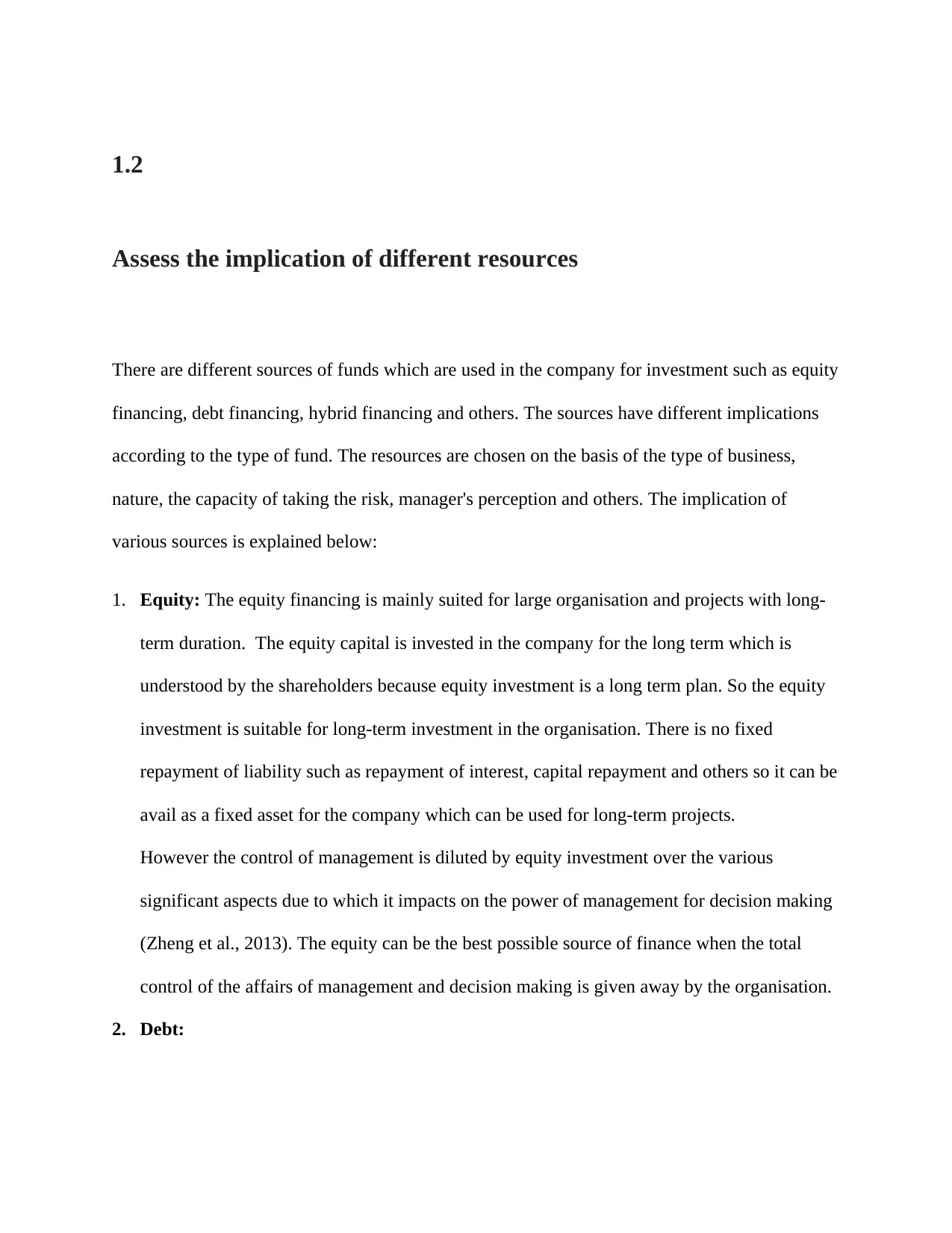
1.2
Assess the implication of different resources
There are different sources of funds which are used in the company for investment such as equity
financing, debt financing, hybrid financing and others. The sources have different implications
according to the type of fund. The resources are chosen on the basis of the type of business,
nature, the capacity of taking the risk, manager's perception and others. The implication of
various sources is explained below:
1. Equity: The equity financing is mainly suited for large organisation and projects with long-
term duration. The equity capital is invested in the company for the long term which is
understood by the shareholders because equity investment is a long term plan. So the equity
investment is suitable for long-term investment in the organisation. There is no fixed
repayment of liability such as repayment of interest, capital repayment and others so it can be
avail as a fixed asset for the company which can be used for long-term projects.
However the control of management is diluted by equity investment over the various
significant aspects due to which it impacts on the power of management for decision making
(Zheng et al., 2013). The equity can be the best possible source of finance when the total
control of the affairs of management and decision making is given away by the organisation.
2. Debt:
Assess the implication of different resources
There are different sources of funds which are used in the company for investment such as equity
financing, debt financing, hybrid financing and others. The sources have different implications
according to the type of fund. The resources are chosen on the basis of the type of business,
nature, the capacity of taking the risk, manager's perception and others. The implication of
various sources is explained below:
1. Equity: The equity financing is mainly suited for large organisation and projects with long-
term duration. The equity capital is invested in the company for the long term which is
understood by the shareholders because equity investment is a long term plan. So the equity
investment is suitable for long-term investment in the organisation. There is no fixed
repayment of liability such as repayment of interest, capital repayment and others so it can be
avail as a fixed asset for the company which can be used for long-term projects.
However the control of management is diluted by equity investment over the various
significant aspects due to which it impacts on the power of management for decision making
(Zheng et al., 2013). The equity can be the best possible source of finance when the total
control of the affairs of management and decision making is given away by the organisation.
2. Debt:
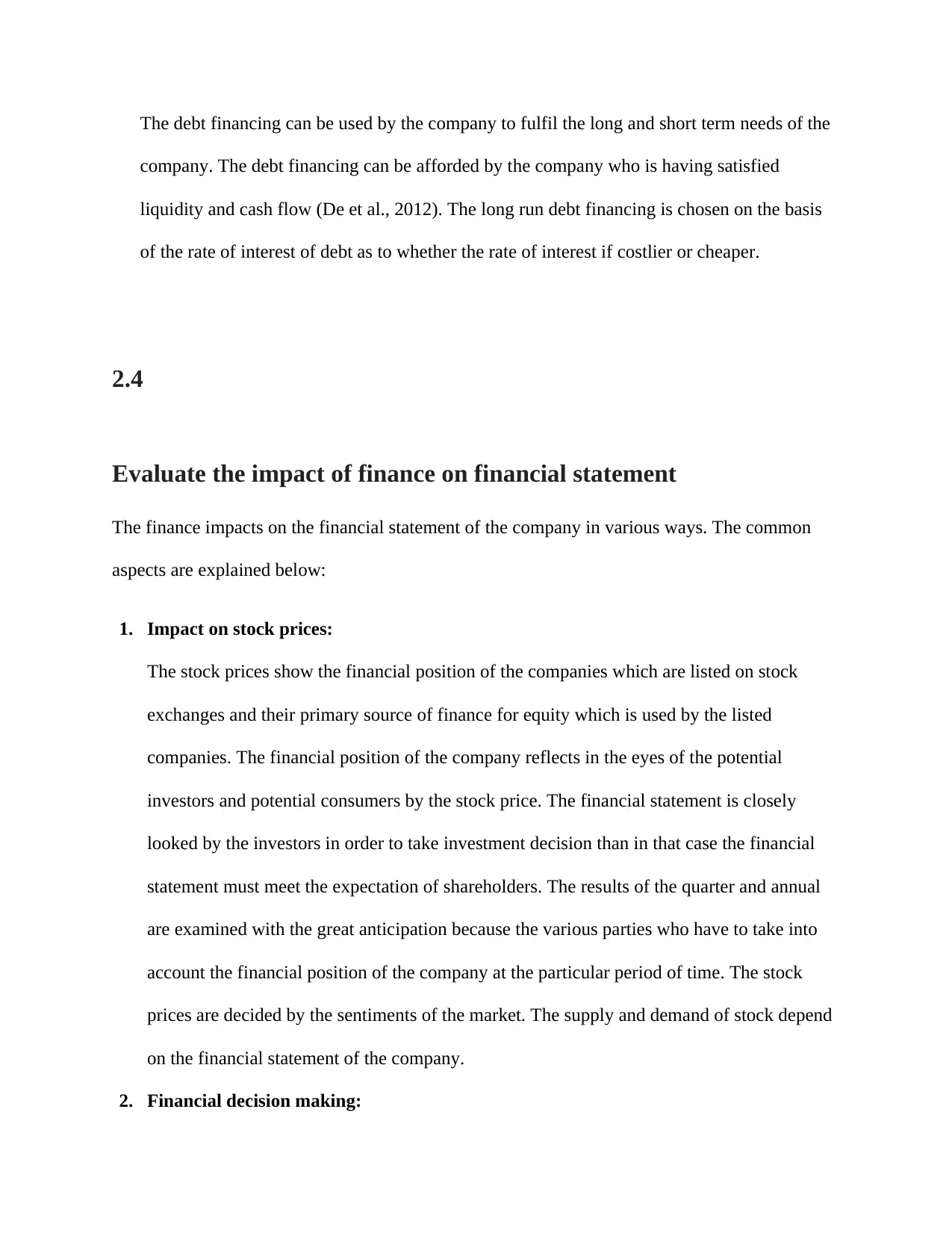
The debt financing can be used by the company to fulfil the long and short term needs of the
company. The debt financing can be afforded by the company who is having satisfied
liquidity and cash flow (De et al., 2012). The long run debt financing is chosen on the basis
of the rate of interest of debt as to whether the rate of interest if costlier or cheaper.
2.4
Evaluate the impact of finance on financial statement
The finance impacts on the financial statement of the company in various ways. The common
aspects are explained below:
1. Impact on stock prices:
The stock prices show the financial position of the companies which are listed on stock
exchanges and their primary source of finance for equity which is used by the listed
companies. The financial position of the company reflects in the eyes of the potential
investors and potential consumers by the stock price. The financial statement is closely
looked by the investors in order to take investment decision than in that case the financial
statement must meet the expectation of shareholders. The results of the quarter and annual
are examined with the great anticipation because the various parties who have to take into
account the financial position of the company at the particular period of time. The stock
prices are decided by the sentiments of the market. The supply and demand of stock depend
on the financial statement of the company.
2. Financial decision making:
company. The debt financing can be afforded by the company who is having satisfied
liquidity and cash flow (De et al., 2012). The long run debt financing is chosen on the basis
of the rate of interest of debt as to whether the rate of interest if costlier or cheaper.
2.4
Evaluate the impact of finance on financial statement
The finance impacts on the financial statement of the company in various ways. The common
aspects are explained below:
1. Impact on stock prices:
The stock prices show the financial position of the companies which are listed on stock
exchanges and their primary source of finance for equity which is used by the listed
companies. The financial position of the company reflects in the eyes of the potential
investors and potential consumers by the stock price. The financial statement is closely
looked by the investors in order to take investment decision than in that case the financial
statement must meet the expectation of shareholders. The results of the quarter and annual
are examined with the great anticipation because the various parties who have to take into
account the financial position of the company at the particular period of time. The stock
prices are decided by the sentiments of the market. The supply and demand of stock depend
on the financial statement of the company.
2. Financial decision making:
⊘ This is a preview!⊘
Do you want full access?
Subscribe today to unlock all pages.

Trusted by 1+ million students worldwide
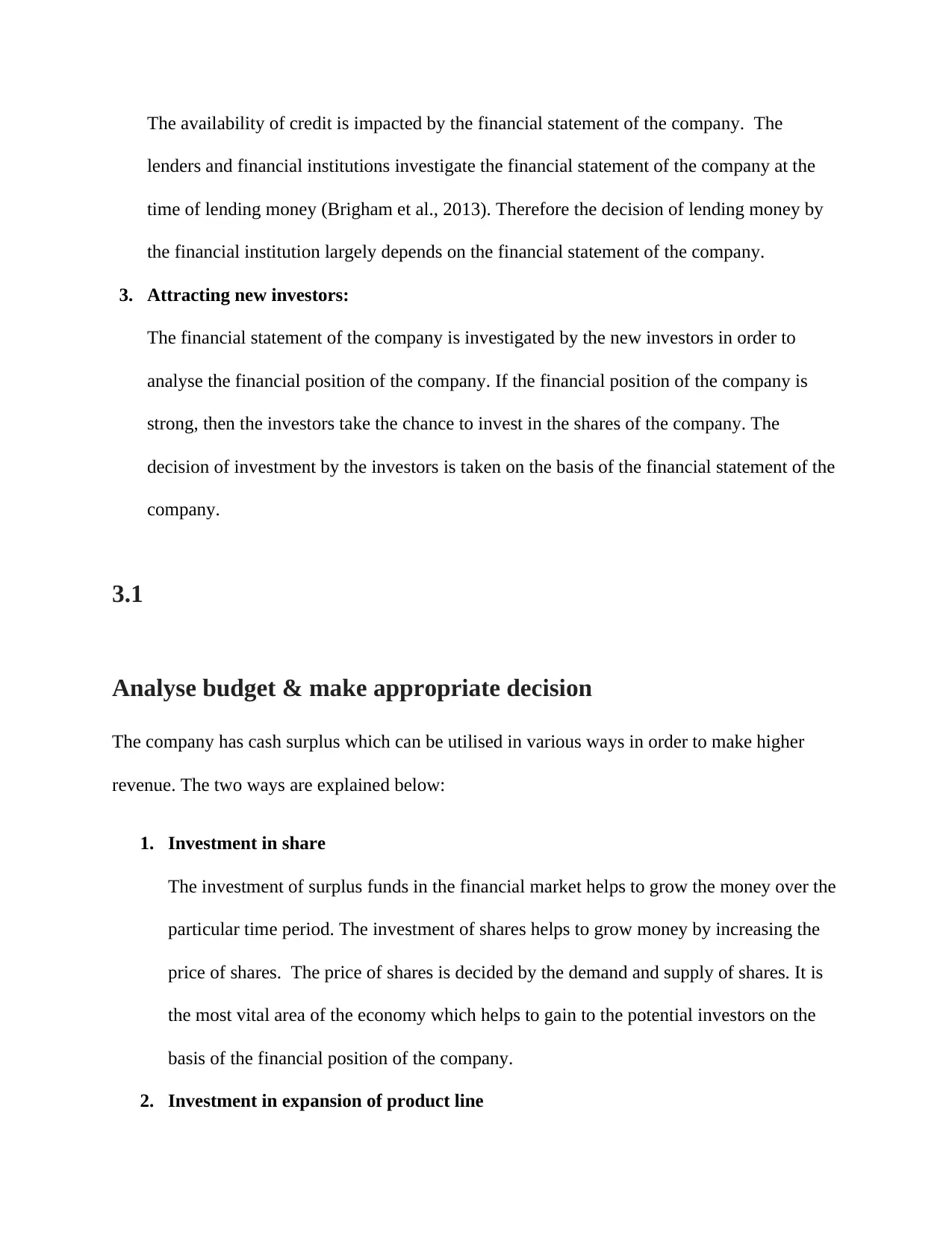
The availability of credit is impacted by the financial statement of the company. The
lenders and financial institutions investigate the financial statement of the company at the
time of lending money (Brigham et al., 2013). Therefore the decision of lending money by
the financial institution largely depends on the financial statement of the company.
3. Attracting new investors:
The financial statement of the company is investigated by the new investors in order to
analyse the financial position of the company. If the financial position of the company is
strong, then the investors take the chance to invest in the shares of the company. The
decision of investment by the investors is taken on the basis of the financial statement of the
company.
3.1
Analyse budget & make appropriate decision
The company has cash surplus which can be utilised in various ways in order to make higher
revenue. The two ways are explained below:
1. Investment in share
The investment of surplus funds in the financial market helps to grow the money over the
particular time period. The investment of shares helps to grow money by increasing the
price of shares. The price of shares is decided by the demand and supply of shares. It is
the most vital area of the economy which helps to gain to the potential investors on the
basis of the financial position of the company.
2. Investment in expansion of product line
lenders and financial institutions investigate the financial statement of the company at the
time of lending money (Brigham et al., 2013). Therefore the decision of lending money by
the financial institution largely depends on the financial statement of the company.
3. Attracting new investors:
The financial statement of the company is investigated by the new investors in order to
analyse the financial position of the company. If the financial position of the company is
strong, then the investors take the chance to invest in the shares of the company. The
decision of investment by the investors is taken on the basis of the financial statement of the
company.
3.1
Analyse budget & make appropriate decision
The company has cash surplus which can be utilised in various ways in order to make higher
revenue. The two ways are explained below:
1. Investment in share
The investment of surplus funds in the financial market helps to grow the money over the
particular time period. The investment of shares helps to grow money by increasing the
price of shares. The price of shares is decided by the demand and supply of shares. It is
the most vital area of the economy which helps to gain to the potential investors on the
basis of the financial position of the company.
2. Investment in expansion of product line
Paraphrase This Document
Need a fresh take? Get an instant paraphrase of this document with our AI Paraphraser
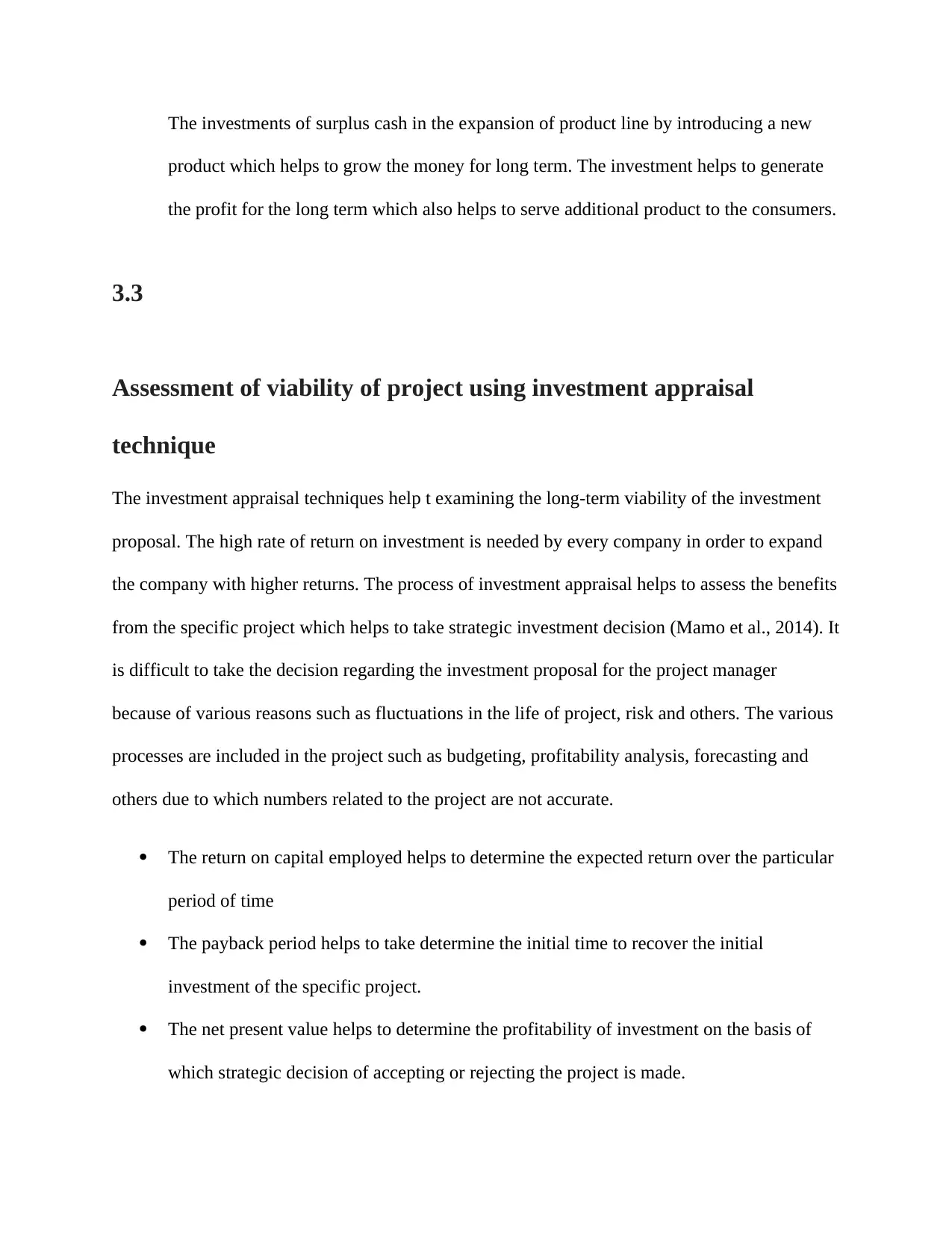
The investments of surplus cash in the expansion of product line by introducing a new
product which helps to grow the money for long term. The investment helps to generate
the profit for the long term which also helps to serve additional product to the consumers.
3.3
Assessment of viability of project using investment appraisal
technique
The investment appraisal techniques help t examining the long-term viability of the investment
proposal. The high rate of return on investment is needed by every company in order to expand
the company with higher returns. The process of investment appraisal helps to assess the benefits
from the specific project which helps to take strategic investment decision (Mamo et al., 2014). It
is difficult to take the decision regarding the investment proposal for the project manager
because of various reasons such as fluctuations in the life of project, risk and others. The various
processes are included in the project such as budgeting, profitability analysis, forecasting and
others due to which numbers related to the project are not accurate.
The return on capital employed helps to determine the expected return over the particular
period of time
The payback period helps to take determine the initial time to recover the initial
investment of the specific project.
The net present value helps to determine the profitability of investment on the basis of
which strategic decision of accepting or rejecting the project is made.
product which helps to grow the money for long term. The investment helps to generate
the profit for the long term which also helps to serve additional product to the consumers.
3.3
Assessment of viability of project using investment appraisal
technique
The investment appraisal techniques help t examining the long-term viability of the investment
proposal. The high rate of return on investment is needed by every company in order to expand
the company with higher returns. The process of investment appraisal helps to assess the benefits
from the specific project which helps to take strategic investment decision (Mamo et al., 2014). It
is difficult to take the decision regarding the investment proposal for the project manager
because of various reasons such as fluctuations in the life of project, risk and others. The various
processes are included in the project such as budgeting, profitability analysis, forecasting and
others due to which numbers related to the project are not accurate.
The return on capital employed helps to determine the expected return over the particular
period of time
The payback period helps to take determine the initial time to recover the initial
investment of the specific project.
The net present value helps to determine the profitability of investment on the basis of
which strategic decision of accepting or rejecting the project is made.
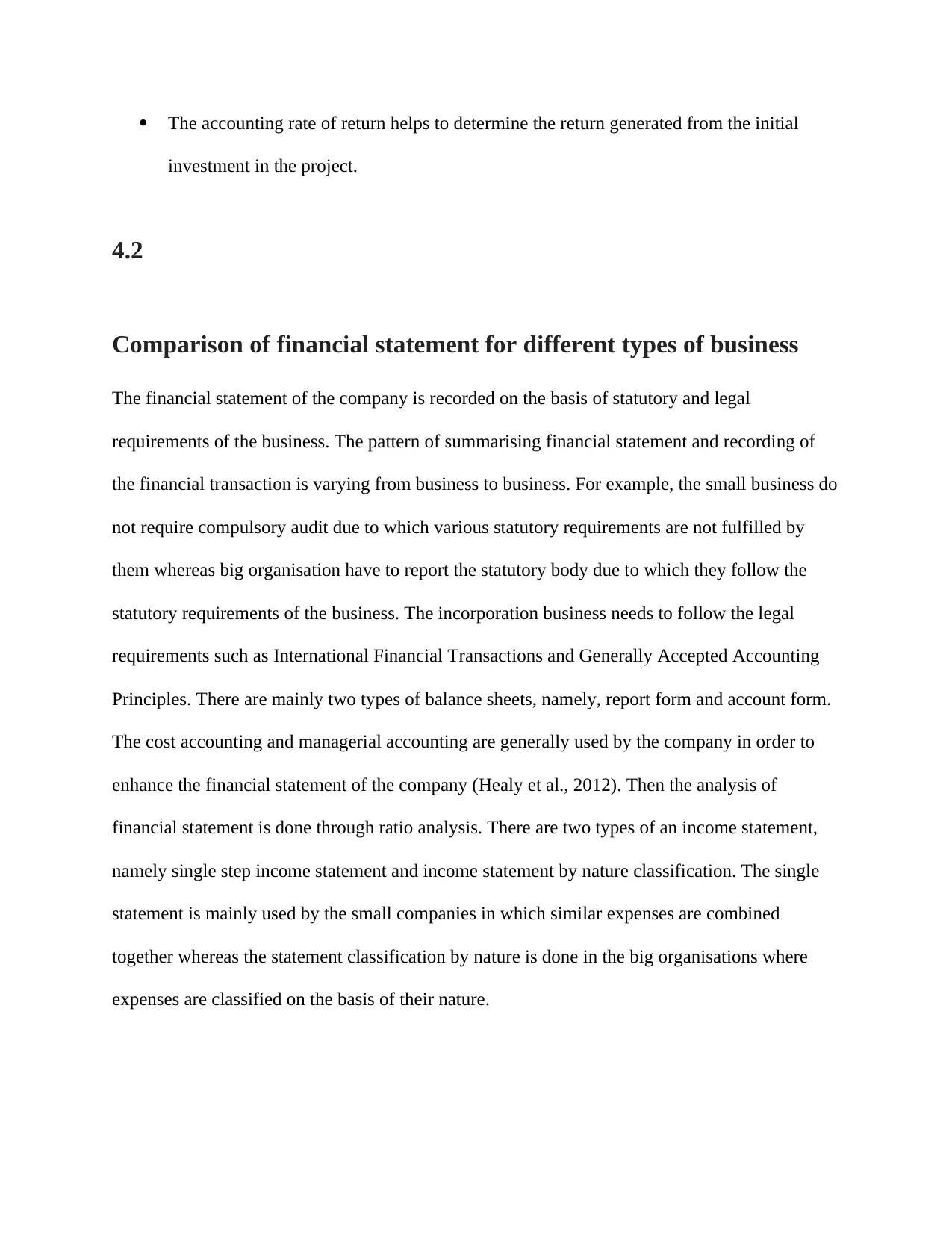
The accounting rate of return helps to determine the return generated from the initial
investment in the project.
4.2
Comparison of financial statement for different types of business
The financial statement of the company is recorded on the basis of statutory and legal
requirements of the business. The pattern of summarising financial statement and recording of
the financial transaction is varying from business to business. For example, the small business do
not require compulsory audit due to which various statutory requirements are not fulfilled by
them whereas big organisation have to report the statutory body due to which they follow the
statutory requirements of the business. The incorporation business needs to follow the legal
requirements such as International Financial Transactions and Generally Accepted Accounting
Principles. There are mainly two types of balance sheets, namely, report form and account form.
The cost accounting and managerial accounting are generally used by the company in order to
enhance the financial statement of the company (Healy et al., 2012). Then the analysis of
financial statement is done through ratio analysis. There are two types of an income statement,
namely single step income statement and income statement by nature classification. The single
statement is mainly used by the small companies in which similar expenses are combined
together whereas the statement classification by nature is done in the big organisations where
expenses are classified on the basis of their nature.
investment in the project.
4.2
Comparison of financial statement for different types of business
The financial statement of the company is recorded on the basis of statutory and legal
requirements of the business. The pattern of summarising financial statement and recording of
the financial transaction is varying from business to business. For example, the small business do
not require compulsory audit due to which various statutory requirements are not fulfilled by
them whereas big organisation have to report the statutory body due to which they follow the
statutory requirements of the business. The incorporation business needs to follow the legal
requirements such as International Financial Transactions and Generally Accepted Accounting
Principles. There are mainly two types of balance sheets, namely, report form and account form.
The cost accounting and managerial accounting are generally used by the company in order to
enhance the financial statement of the company (Healy et al., 2012). Then the analysis of
financial statement is done through ratio analysis. There are two types of an income statement,
namely single step income statement and income statement by nature classification. The single
statement is mainly used by the small companies in which similar expenses are combined
together whereas the statement classification by nature is done in the big organisations where
expenses are classified on the basis of their nature.
⊘ This is a preview!⊘
Do you want full access?
Subscribe today to unlock all pages.

Trusted by 1+ million students worldwide
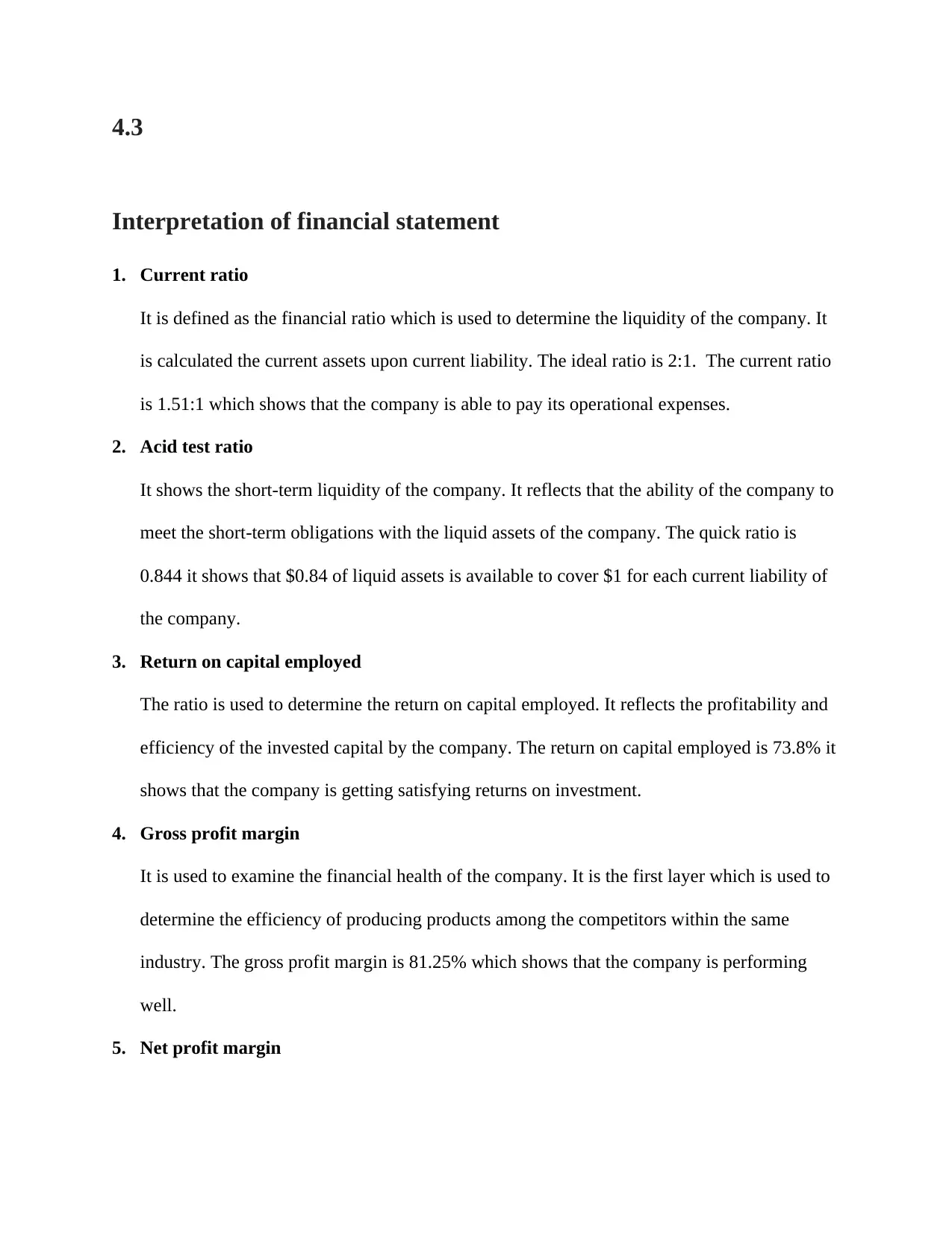
4.3
Interpretation of financial statement
1. Current ratio
It is defined as the financial ratio which is used to determine the liquidity of the company. It
is calculated the current assets upon current liability. The ideal ratio is 2:1. The current ratio
is 1.51:1 which shows that the company is able to pay its operational expenses.
2. Acid test ratio
It shows the short-term liquidity of the company. It reflects that the ability of the company to
meet the short-term obligations with the liquid assets of the company. The quick ratio is
0.844 it shows that $0.84 of liquid assets is available to cover $1 for each current liability of
the company.
3. Return on capital employed
The ratio is used to determine the return on capital employed. It reflects the profitability and
efficiency of the invested capital by the company. The return on capital employed is 73.8% it
shows that the company is getting satisfying returns on investment.
4. Gross profit margin
It is used to examine the financial health of the company. It is the first layer which is used to
determine the efficiency of producing products among the competitors within the same
industry. The gross profit margin is 81.25% which shows that the company is performing
well.
5. Net profit margin
Interpretation of financial statement
1. Current ratio
It is defined as the financial ratio which is used to determine the liquidity of the company. It
is calculated the current assets upon current liability. The ideal ratio is 2:1. The current ratio
is 1.51:1 which shows that the company is able to pay its operational expenses.
2. Acid test ratio
It shows the short-term liquidity of the company. It reflects that the ability of the company to
meet the short-term obligations with the liquid assets of the company. The quick ratio is
0.844 it shows that $0.84 of liquid assets is available to cover $1 for each current liability of
the company.
3. Return on capital employed
The ratio is used to determine the return on capital employed. It reflects the profitability and
efficiency of the invested capital by the company. The return on capital employed is 73.8% it
shows that the company is getting satisfying returns on investment.
4. Gross profit margin
It is used to examine the financial health of the company. It is the first layer which is used to
determine the efficiency of producing products among the competitors within the same
industry. The gross profit margin is 81.25% which shows that the company is performing
well.
5. Net profit margin
Paraphrase This Document
Need a fresh take? Get an instant paraphrase of this document with our AI Paraphraser
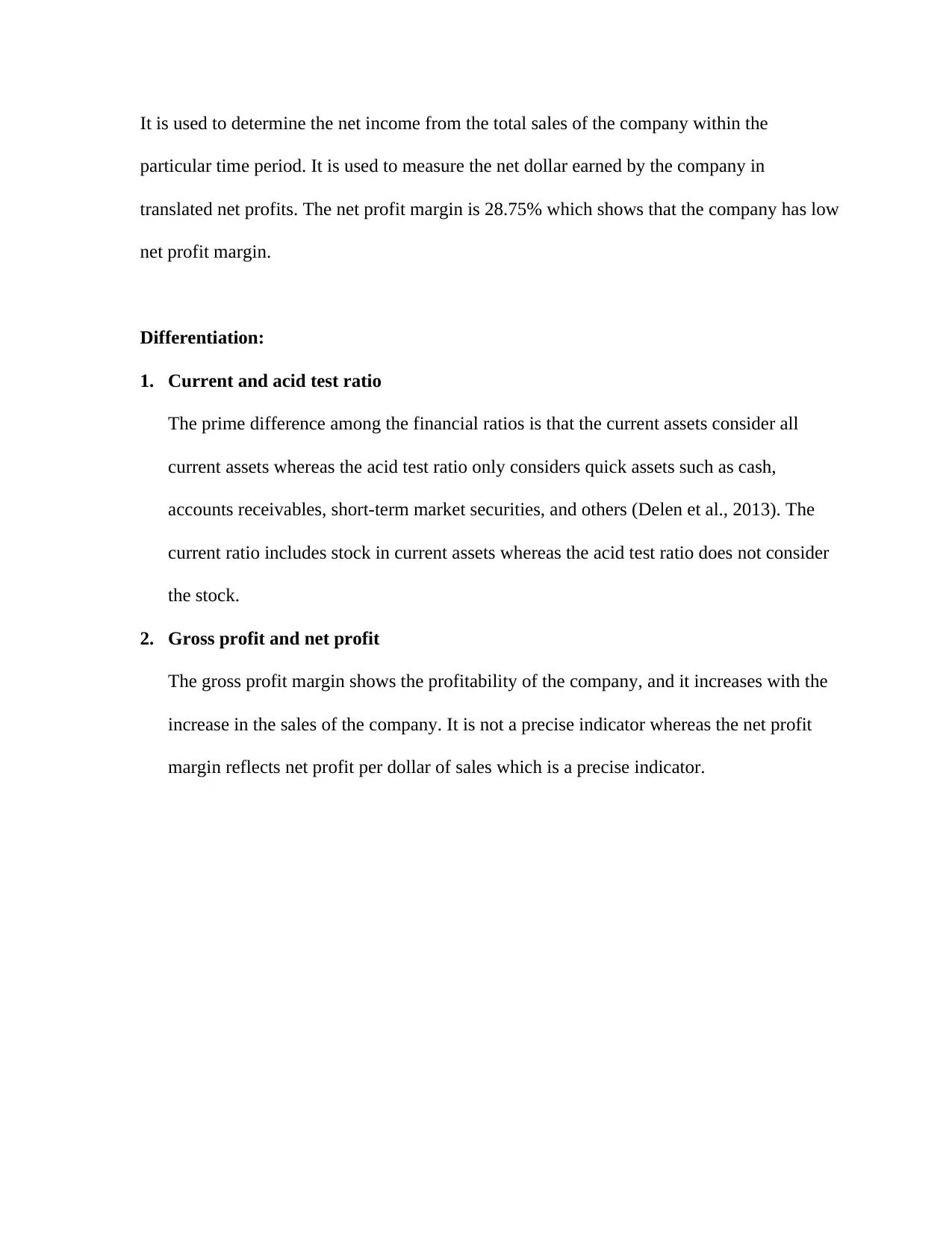
It is used to determine the net income from the total sales of the company within the
particular time period. It is used to measure the net dollar earned by the company in
translated net profits. The net profit margin is 28.75% which shows that the company has low
net profit margin.
Differentiation:
1. Current and acid test ratio
The prime difference among the financial ratios is that the current assets consider all
current assets whereas the acid test ratio only considers quick assets such as cash,
accounts receivables, short-term market securities, and others (Delen et al., 2013). The
current ratio includes stock in current assets whereas the acid test ratio does not consider
the stock.
2. Gross profit and net profit
The gross profit margin shows the profitability of the company, and it increases with the
increase in the sales of the company. It is not a precise indicator whereas the net profit
margin reflects net profit per dollar of sales which is a precise indicator.
particular time period. It is used to measure the net dollar earned by the company in
translated net profits. The net profit margin is 28.75% which shows that the company has low
net profit margin.
Differentiation:
1. Current and acid test ratio
The prime difference among the financial ratios is that the current assets consider all
current assets whereas the acid test ratio only considers quick assets such as cash,
accounts receivables, short-term market securities, and others (Delen et al., 2013). The
current ratio includes stock in current assets whereas the acid test ratio does not consider
the stock.
2. Gross profit and net profit
The gross profit margin shows the profitability of the company, and it increases with the
increase in the sales of the company. It is not a precise indicator whereas the net profit
margin reflects net profit per dollar of sales which is a precise indicator.
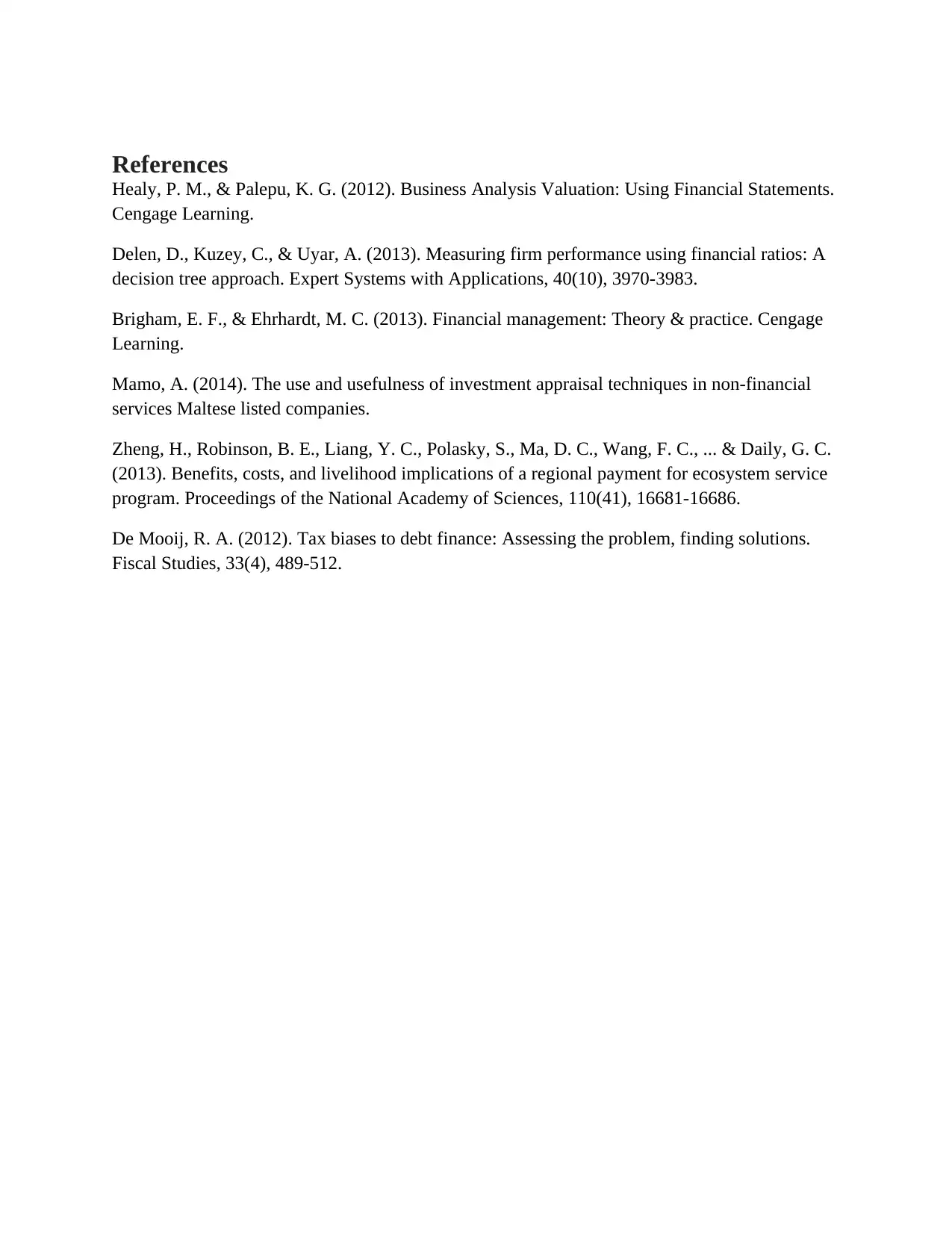
References
Healy, P. M., & Palepu, K. G. (2012). Business Analysis Valuation: Using Financial Statements.
Cengage Learning.
Delen, D., Kuzey, C., & Uyar, A. (2013). Measuring firm performance using financial ratios: A
decision tree approach. Expert Systems with Applications, 40(10), 3970-3983.
Brigham, E. F., & Ehrhardt, M. C. (2013). Financial management: Theory & practice. Cengage
Learning.
Mamo, A. (2014). The use and usefulness of investment appraisal techniques in non-financial
services Maltese listed companies.
Zheng, H., Robinson, B. E., Liang, Y. C., Polasky, S., Ma, D. C., Wang, F. C., ... & Daily, G. C.
(2013). Benefits, costs, and livelihood implications of a regional payment for ecosystem service
program. Proceedings of the National Academy of Sciences, 110(41), 16681-16686.
De Mooij, R. A. (2012). Tax biases to debt finance: Assessing the problem, finding solutions.
Fiscal Studies, 33(4), 489-512.
Healy, P. M., & Palepu, K. G. (2012). Business Analysis Valuation: Using Financial Statements.
Cengage Learning.
Delen, D., Kuzey, C., & Uyar, A. (2013). Measuring firm performance using financial ratios: A
decision tree approach. Expert Systems with Applications, 40(10), 3970-3983.
Brigham, E. F., & Ehrhardt, M. C. (2013). Financial management: Theory & practice. Cengage
Learning.
Mamo, A. (2014). The use and usefulness of investment appraisal techniques in non-financial
services Maltese listed companies.
Zheng, H., Robinson, B. E., Liang, Y. C., Polasky, S., Ma, D. C., Wang, F. C., ... & Daily, G. C.
(2013). Benefits, costs, and livelihood implications of a regional payment for ecosystem service
program. Proceedings of the National Academy of Sciences, 110(41), 16681-16686.
De Mooij, R. A. (2012). Tax biases to debt finance: Assessing the problem, finding solutions.
Fiscal Studies, 33(4), 489-512.
⊘ This is a preview!⊘
Do you want full access?
Subscribe today to unlock all pages.

Trusted by 1+ million students worldwide
1 out of 9
Related Documents
Your All-in-One AI-Powered Toolkit for Academic Success.
+13062052269
info@desklib.com
Available 24*7 on WhatsApp / Email
![[object Object]](/_next/static/media/star-bottom.7253800d.svg)
Unlock your academic potential
Copyright © 2020–2025 A2Z Services. All Rights Reserved. Developed and managed by ZUCOL.





